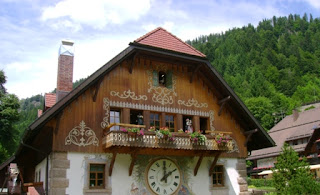Visiting National Museum of Indian Cinema - 2: The Modern Glass Galleries
After visiting the Gulshan Mahal bungalow galleries, you move to the Modern Glass Galleries. Spread over four floors, it was a delightful interactive experience and incorporated everything about cinema as reflected in the famous words of a director on sets "Lights, camera, action!" (and sound techniques too, of course). Hats off to the curator and the team who have put so much time and effort into setting up the galleries across the two spaces (the bungalow, and the new building) of the National Museum of Indian Cinema, Mumbai.
First Floor Gallery:
Gandhiji & Cinema
Immediately to your left as you enter is a poster titled ‘Mohan and Harishchandra’ This refers to when Gandhiji as a child watched the play ‘Harishchandra’, the protagonist of which impressed Gandhiji with his truthful character.
In his turn, Gandhiji’s political philosophy and practice
influenced many filmmakers worldwide, with his message of peace and
non-violence and social reforms conveyed on the silver screen. The exhibition
in this gallery explores the trajectories of Gandhiji’s impact on Indian and
international cinema.
It was fascinating to pick up the old-fashioned phone
installed on the wall to listen to the narration of 'Harishchandra'. Next to it,
larger than life is Gandhiji seated on a chair in front of a screen watching
Ram Rajya (directed by Vijay Bhat), believed to be the only film Gandhiji
saw.
An interactive screen leads you through six chapters of
‘Films and the Freedom Movement’.
 |
| Interactive Screen on Films and the Freedom Movement |
 |
| Section showing Gandhiji's influence on World Cinema |
There are also interesting nuggets of information on the display boards, such as that although Gandhiji had no liking for cinema, he addressed several public meetings conducted by local social organizations at some cinema houses in Mumbai, such as Opera House, Empire, and Excelsior.
Second Floor Gallery:
Children’s Film Studio
This gallery was huge fun! It provides a hands-on
experience in cinematic techniques. Try your hand at making a short animated
feature on Chota Bheem, the endearing boy in the popular Indian animated
television series of the same name.
 |
| Create an Animation Film |
Ahead is a platform on which you can stand and, with simple hand gestures, select a theme as a backdrop and make a VFX movie sequence. Fascinating!
Then there is the large studio set. You can sit amid the scenery on the platform, get someone to aim the camera at you (the director’s chair was missing here), and then you appear with the backdrop on the screen below the camera.
 |
| Model of a Film Studio Set |
Another interesting interactive screen was the one on Visual
Effects. Unfortunately, though, the interactive screens in the virtual makeover booth were not
working.
 |
| Virtual Makeover Booth |
Third Floor Gallery: Technological Innovations in Indian Cinema
The exhibits here showcase how filmmakers used technology
to create cinematographic impact, starting with Dadasaheb Phalke's animation techniques in his
early films. Did you know that India is credited with the development of the
first playback music in cinema?
The sound section was my favourite across all the galleries. In a booth, there is a superb interactive screen where you can put on headphones, sit comfortably, listen to how sound effects are created as per the scene and location, and learn the significant roles editors and re-recording artists play. It was fun listening to the famous Gabbar dialogue "Kitne aadmi the" (how many men were there?) and the sound of his boots in the iconic film Sholay. Then there is the nugget about 'walla, walla, walla' that actors said – why? And do you know how a Foley artist creates the sound of a horse's gallop? Visit the museum and find out for yourself! (the answer to the second is on the cutout of a recording reel up on a wall.)
 |
| Sound Effects Screen |
Cameras, microphones, sound recorders, audio mixers, even a mammoth film cleaning machine and a film printer…a superb range of equipment is displayed, with place cards on pedestals explaining their use.
 |
| Film-cleaning machine (right) with a film printer (left) |
The centrepiece has lifelike figures of editors at work. Awesome!
 |
| Editors at Work |
The first exhibit here is a colourful tent, harking back to the era when there were no cinema halls and travelling exhibitors went around
towns and villages to pitch tents on open grounds to show films, just like a
circus. Stepping through, you will find a bioscope. Bring out the child in you,
sit, and peer in!
Here, too, are movie projectors and cameras, as well as lights and lamps used for lighting effects.
 |
| Arri 2C Handheld Camera with Shoulder Pod |
One section is reserved for the pioneering filmmaker Satyajit
Ray, with a display of the various types of cameras he used.
Check out another piece of Indian film history- the
certificates issued by the Censor Board.
 |
| Censor Board Certificates |
 |
| First 3D film in India |
 |
| Listen to the olden goldies! |
It was with a feeling of contentment that I stepped out and
sat for a while, scrolling through the many photos I had taken, absorbing the
experience of it all. VFM and well worth a second visit, for sure!
NMIC Mumbai Museum Address-
24, Dr. G. Deshmukh Marg (Pedder Road), Cumballa Hill, Mumbai- 400026.
Ph: +91-022-23551377
Email: nmic@filmsdivision.org / nmicmumbai@nfdcindia.com
Website: https://nmicindia.com/





Comments
Post a Comment